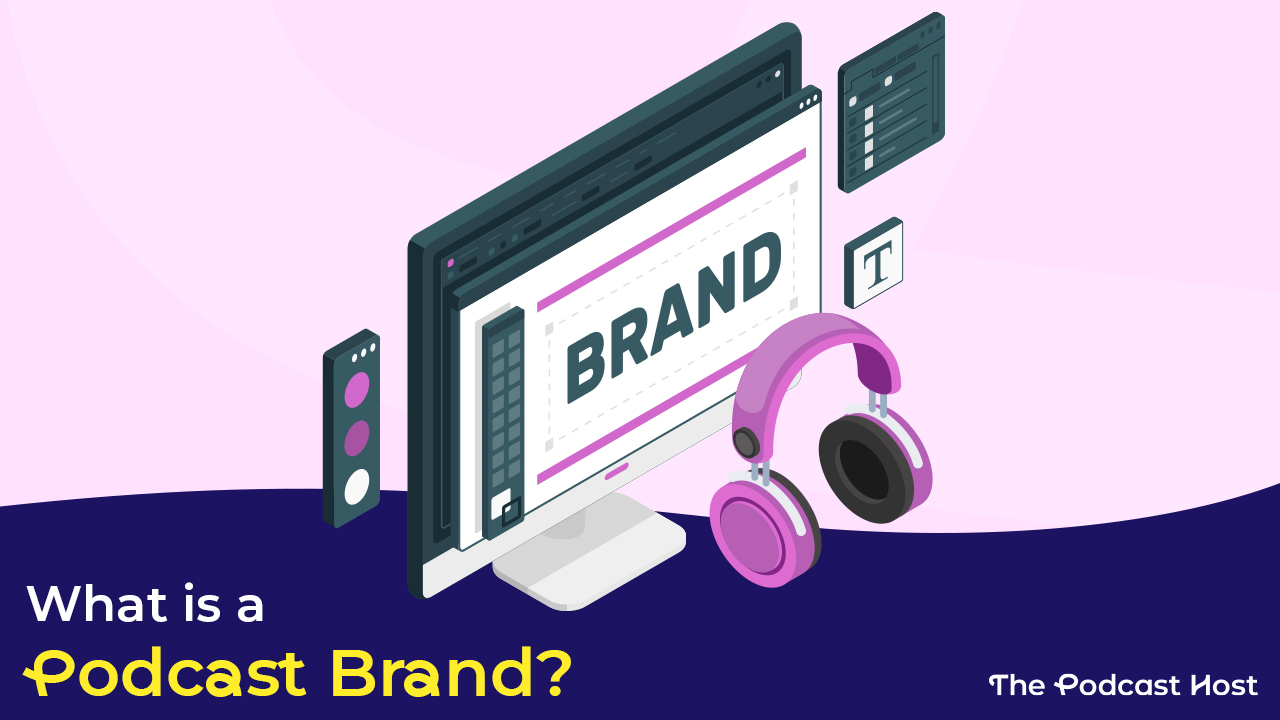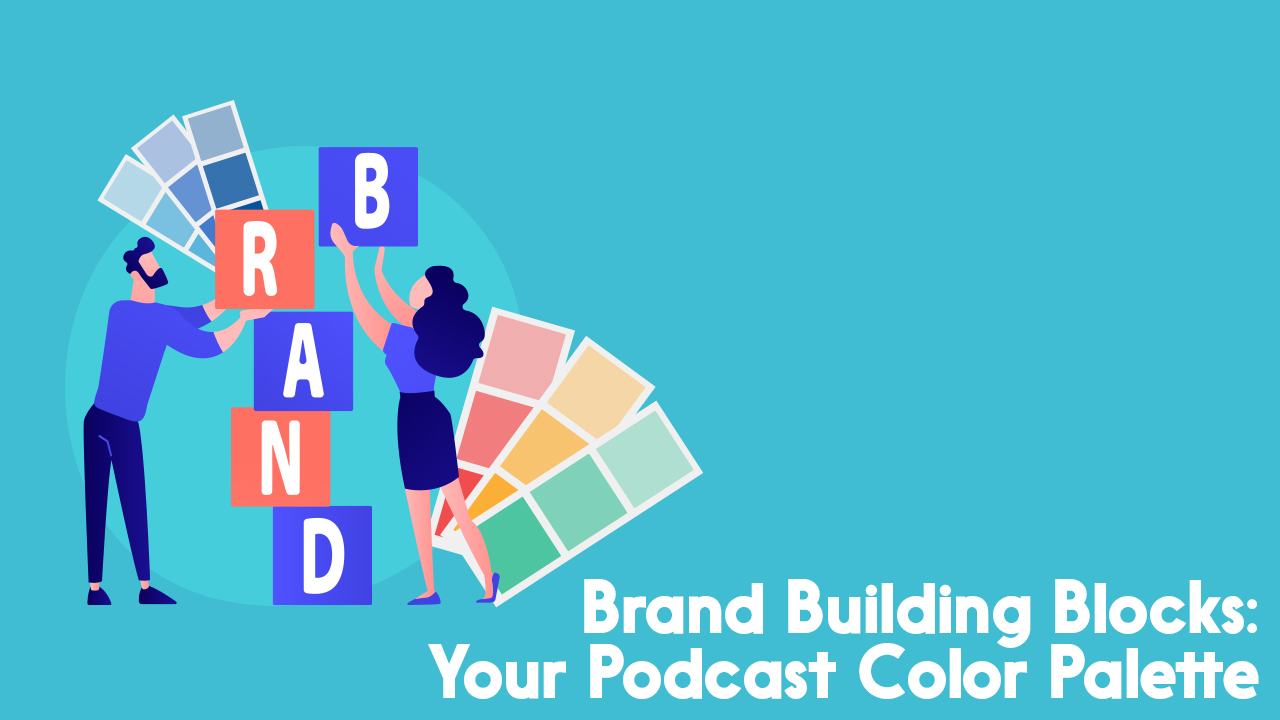What is a Podcast Brand, and How Do You Make it Unforgettable?

I’ll be honest with you, “brand” is a buzzword, but knowing your podcast brand is important.
The term brand tends to be overused, and a tad bit misunderstood. But, it’s an important one in the podcasting industry. In fact, knowing your podcast brand can make everything from writing an episode to marketing it significantly easier.
What is a Podcast Brand, Actually?
I’m no marketing historian, but I do come from a rural family and I’ve spent a little time (like that one summer when I was 12) at a cattle branding, and I assume that the term “brand” or “branding” as we refer to it in marketing comes from that same concept.
Way back in the day, cattle theft was a big problem. So, ranchers started, quite literally, to brand their cattle with their name so in case of theft, it would be easy to identify.
This practice still exists today, and where I come from it’s often called a “branding party” — but that’s not the point of this story. The point is, the brand told anyone who looked at the cattle who it belonged to. That way, if there was any dispute, it could be returned to its rightful owner.
Branding in marketing works in a similar way.
A brand for a company, product, or, in our case, podcast, helps those that come across it understand instantly what it is or who it belongs to.
But, in marketing, we go beyond just the collection of letters, numbers, and symbols that make up the logo. A brand essentially sums up how people feel about and interact with your product (with the product in this case being your podcast).
Brand Identity
Your overall podcast brand identity covers both your brand assets (we’ll get to these) and what your brand represents. It encompasses how both current listeners and future ones perceive and feel about your brand. And you have way more control over it than you think.
Shaping your brand identity takes time, and the most important factor is consistency.
To deliver a strong brand identity, you need to:
- Identify your brand’s unique value proposition (what you offer that no one else does)
- Figure out who your target audience is
- Craft a consistent message
- Develop creative brand assets
A brand’s identity evolves continually, so once you’re established you’ll want to regularly analyze and refine it. Checking in on an annual basis can be a good way to make sure that what you’re putting out matches your brand identity.
Brand Assets
The biggest misconception about branding comes in when creators and business owners confuse their logo and other visual pieces with their brand identity. While these visual representations are an important part of your brand, they don’t make up the whole thing — a logo can’t tell you the spirit of the brand, it only tells you what it looks like.
Brand assets are the visual components of a brand. These should be recognizable, timeless (with some exceptions), and embody the overall personality and feeling of your brand. The most important of these that every podcaster should have, include:
- Logo
- Podcast cover artwork
- Typeface / fonts
- Colors
- Images
- Graphics
These are not all equal, but they are all important. So, let’s dig a tiny bit into each one so we can get a feel for how it adds to your overall brand.

Logo
Your brand’s logo is how people identify you at a glance. You can use these on things like your website, products (merch), contracts and paperwork, and anything else you put out there. This way, everything’s easily identifiable.
Logos should be:
- Simple
- Relevant
- Memorable
- Versatile
Most importantly, your logo is not your podcast cover artwork.
You want to put some real effort into designing your logo (or get a professional). In most cases, it’s the first visual representation of your brand that people experience. But logos change as brands grow, so don’t be afraid to let them evolve over time.
It’s a common misconception that brands only have one logo, most have, at minimum, three:
- A full color logo
- A black or white logo (often both)
- An icon, which is a small, often wordless version of the logo (think Walmart’s six-pronged sun without the word “Walmart” beside it)
Then there are logo variants. Perhaps you have a single-color logo in each brand color, or a full-text and slogan logo and one that simply has the brand name and icon. There can also be seasonal and special occasion logos, like a pride logo to display in June, a red and green logo to display over the winter holiday season, and even a Halloween-themed logo.
You can have as many logos as your heart desires, but I recommend keeping it as simple as possible in the beginning. You’ll also want to build a solid brand guideline and have some sort of brand asset management strategy in place if you have multiple logos and are working with partners who are displaying your logo.
Cover Art
Not every brand has podcast cover art, but every podcast needs one — you actually can’t submit to podcast directories without one.
Your cover art is not your logo. It can contain your logo, but it shouldn’t be the full thing because you’ll be limiting your brand for other shows and product variations in the future.
When you first start out your show might be your full brand. But if you want in building a business in the future, you want to leave the door open to expand. If your logo is associated directly with your show, it’ll be hard to pry that away and build on it.
Your cover artwork needs to visually represent your show, along with your podcast brand. So, if your show is a serious interview series, you probably don’t want your cover art to exude a comedy feel. Likewise, greyscale cover art is probably the wrong direction to go for a fun, family-friendly show.
I wholeheartedly recommend that you get a professional to design your artwork. In most cases, this will be the first thing people experience about your show, even before they press the play button. So, you want it to be eye-catching and memorable.
We also sometimes see variations of artwork for different podcast episode themes or subjects. This is absolutely OK, but you want to make sure that you have a primary one that podcast audiences can easily identify.
Typeface
Typeface and fonts are often overlooked as a brand asset. But, they’re incredibly important.
While a well-thought-out font strategy doesn’t necessarily add to your brand (though some would fight me on this), a poor one can quickly reduce the quality of it.
You want to be working with a single set of fonts, two or three headers, a body font, and maybe a title font. They all need to work together visually, and match the feel of your brand — a business podcast probably shouldn’t use fonts like Comic Sans (honestly, no one should) or Quick Run, likewise a comedy podcast should probably avoid using a more serious-toned font like Times New Roman.
Your fonts should:
- Be easy to read
- Match well together
- Be in-line with your podcast branding
Honestly, fonts can be one of the hardest (and most overlooked) parts of branding. If you’re struggling with them, a font combinations generator like Fontjoy can help you find ones that work well together.
Colors
Your podcast branding needs to include a set of colors that you use on everything.
You want to avoid straying too much from these brand colors, so your target audience isn’t confused. Using a ton of colors simply because they look good can make your brand feel confused.
Brand colors should be simple, and you want to try to do more with less. Most brands have three primary colors (one is usually a black or white variation) and up to four secondary colors.
Primary colors show up on your logo, website, and all branded materials. Whereas secondary colors usually show up one at a time and serve to accent your primaries.
There are two easy methods that you can start building your podcast brand colors:
1. Trends: A tool like Coolors can show you current trending color palettes that may spark some inspiration for your own brand.
2. Image-first: Select an image that visually represents the brand colors you’re toying with and put it into Canva. Their tool shows you the different colors so you can start building your own palette.
Brand colors often change as a brand matures. Brands usually end up narrowing colors down as they grow, ending up with far fewer than they started out with.
Images
Brand imagery can be confusing, especially when your primary source of images is from databases like Unsplash and Pexels. Much like fonts, well-thought-out imagery often goes unnoticed, but poorly choices stick out like a sore thumb.
The visuals you include should all convey the same look and feel. If your brand is minimalistic, images packed to the brim with visuals are probably a bad choice. Likewise, if bold and playful is your podcast brand personality, black-and-white only images probably won’t suffice.
It can be challenging to get a handle on your brand imagery, but you want to source images that portray the same look and feel across the board.
Graphics
Graphics fall under the same heading as images — making sure the look and feel are consistent, with the exception of one difference: social media templates.
When it comes to branding podcasts, if you want to use graphics (instead of or in addition to images), you want to make sure that the style of graphics and what they represent is consistent across the entire brand. That means, if you use faceless people in your images, don’t suddenly put out one with faces. Likewise, don’t mix line art with boxy graphics, use rounded or straight edges consistently — just make sure you’re consistent.
When you’re posting on social media platforms you also want to be consistent, and one of the best ways to do this is through building (or getting built for you) a series of branded templates for the social media platforms you work in.
Templates make your brand visually stronger and help you create graphics faster. That way you can focus your social media efforts on podcast engagement with your loyal listeners.
I recommend getting five to ten different templates created for each platform that you use. This gives you a varied but consistent brand. On Instagram, in particular, nine is a great number because that’s the initial set that someone sees when they’re on your profile.
Creating a Brand Identity
There is no simple way to create a podcast brand identity. While you can hire it out (which helps particularly in the visual asset aspect), you are the only one who knows what you plan to deliver. Unless you have your value and target audience refined, even the best branding work won’t build you an accurate dynamic brand strategy.
If you’re just starting out, check out Podcraft Academy. It can help you define your show and audience, and put together the groundwork that you need to craft a lasting brand identity.

